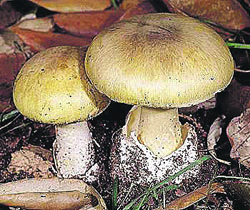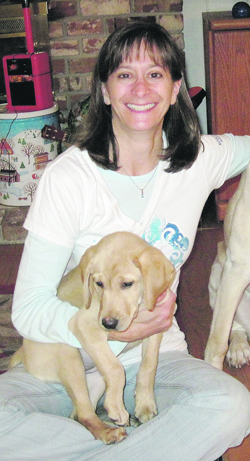| | Published December 19th, 2012
| Poisonous Mushrooms
| | By Mona Miller, DVM |  | |
|
In light of the recent warning issued by the California Department of Public Health to discourage collection and consumption of wild mushrooms, I thought I would discuss the danger of wild mushrooms to pets, especially dogs. Some dogs are attracted to mushrooms with a fishy odor, while other dogs are non-discriminating and will eat anything of interest in the backyard or on the trail. Mushrooms can be classified according to their type of toxin; of these eight categories, six are important as potential pet toxicities. Some cause liver failure, some cause gastrointestinal irritation, and others cause neurologic disease. As an aside, most edible, store-bought mushrooms are non-toxic to dogs, although a change from regular diet may contribute to indigestion and stomach upset.
 The most common poisonous mushrooms in the Bay Area are Amanita and Galerina species. These are found almost year-round, but especially from fall through spring. Amanita species are the most common mushrooms involved in both dog and human fatal poisonings, with Amanita phalloides (commonly called the Death Cap Mushroom) at the top of the list. The toxins in Amanita sp. are quickly absorbed from the intestines, and then cause both liver and kidney disease. There can be up to 12 hours between ingestion of the mushroom and illness. Initial symptoms are related to the gastrointestinal tract and include nausea, vomiting, diarrhea and abdominal pain. Further symptoms in the first 24-36 hours are fever, rapid heart rate, changes in serum electrolytes and glucose. Then liver and kidney systems become affected and will start to fail. Without treatment, death can occur in three to seven days.
The most common poisonous mushrooms in the Bay Area are Amanita and Galerina species. These are found almost year-round, but especially from fall through spring. Amanita species are the most common mushrooms involved in both dog and human fatal poisonings, with Amanita phalloides (commonly called the Death Cap Mushroom) at the top of the list. The toxins in Amanita sp. are quickly absorbed from the intestines, and then cause both liver and kidney disease. There can be up to 12 hours between ingestion of the mushroom and illness. Initial symptoms are related to the gastrointestinal tract and include nausea, vomiting, diarrhea and abdominal pain. Further symptoms in the first 24-36 hours are fever, rapid heart rate, changes in serum electrolytes and glucose. Then liver and kidney systems become affected and will start to fail. Without treatment, death can occur in three to seven days.
 When early and aggressive treatment is instituted, the overall prognosis is good. If a dog has just ingested mushrooms and not yet shown signs, he may be made to vomit. Additionally, a binding substance called activated charcoal will be introduced into his stomach to capture any toxin not yet absorbed into the bloodstream. This can be repeated several times over the next 48 hours in order to continue to bind active toxin. Further supportive care includes hospitalization, intravenous fluids, gastrointestinal medications for nausea and vomiting. Anti-oxidant medication can be given to further reduce damage to liver and kidney cells. Blood tests will be performed to monitor kidney and liver organs, as well as blood sugar and electrolytes.
When early and aggressive treatment is instituted, the overall prognosis is good. If a dog has just ingested mushrooms and not yet shown signs, he may be made to vomit. Additionally, a binding substance called activated charcoal will be introduced into his stomach to capture any toxin not yet absorbed into the bloodstream. This can be repeated several times over the next 48 hours in order to continue to bind active toxin. Further supportive care includes hospitalization, intravenous fluids, gastrointestinal medications for nausea and vomiting. Anti-oxidant medication can be given to further reduce damage to liver and kidney cells. Blood tests will be performed to monitor kidney and liver organs, as well as blood sugar and electrolytes.
 If you suspect your dog has eaten wild mushrooms, bring samples of these fungi to your veterinarian when you bring your dog in. Identification of the specific type of mushroom ingested can be very helpful in developing a treatment plan.
If you suspect your dog has eaten wild mushrooms, bring samples of these fungi to your veterinarian when you bring your dog in. Identification of the specific type of mushroom ingested can be very helpful in developing a treatment plan.
 Useful websites for mushroom identification and photos can be found at http://bayareamushrooms.org/poisonings and http://namyco.org/toxicology (North American Mycological Association). Useful websites for mushroom identification and photos can be found at http://bayareamushrooms.org/poisonings and http://namyco.org/toxicology (North American Mycological Association).

|
 | | Death cap Photo Michael Wood www.mykoweb.com |  | | Dr. Mona Miller lives in Lafayette with her young son, two cats and Luka a new puppy. She has worked at Four Seasons Animal Hospital in Lafayette since moving here in 2001. She attended Cal as an undergrad, and received her DVM from U.C. Davis. She can be reached at Four Seasons, 938-7700, or by email to MonaSDVM@aol.com.
| | | | | | | | | Advertisement | | |
| | | print story
Before you print this article, please remember that it will remain in our archive for you to visit anytime.
download pdf
(use the pdf document for best printing results!) | | | Comments | | |
| | | | | | | | | | | | | | | | |




